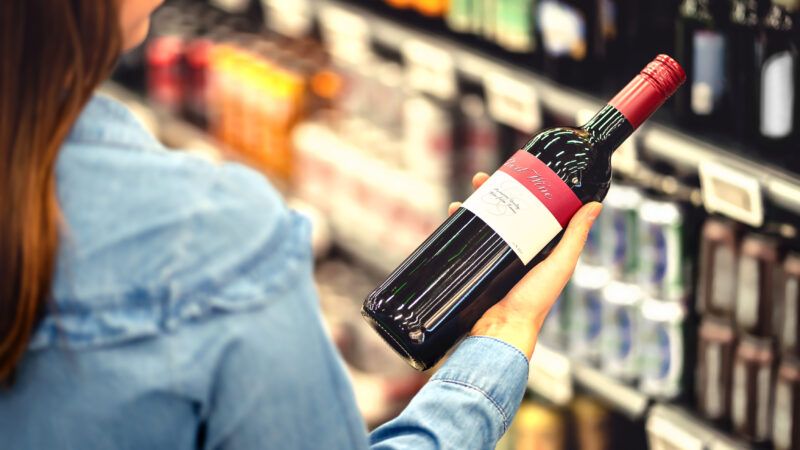Activist Groups Demand Feds Require Nutrition Labels on Booze
Plaintiffs want the nanny state to nanny harder.

A federal lawsuit filed last week by the Center for Science in the Public Interest, the Consumer Federation of America, and the National Consumers League seeks to force alcohol beverage makers to include nutrition information—including alcohol content (ABV), calorie, and ingredient information—on their products. One food website suggested the suit was timed to coincide with President Joe Biden's proposed development of a national food strategy, which I largely panned last week.
The groups sued the government after the Treasury Department's Alcohol and Tobacco Tax and Trade Bureau (TTB), which administers alcohol taxes and oversees most alcohol labeling, failed to take action in response to a 2003 petition and subsequent communications filed over nearly two decades. CSPI has pushed for mandatory nutrition labeling on alcohol beverage containers nearly since its inception in the early 1970s. As a Treasury document published earlier this year declares, "Treasury has considered ingredient labeling requirements since at least 1972, when the Center for Science in the Public Interest petitioned for it." Most recently, CSPI, CFA, and other groups wrote last year to Treasury Secretary Janet Yellen about what they say was a need to "improv[e] alcohol labeling to protect public health."
The plaintiffs are correct that the federal government has improperly ignored and failed to address or reject the issues raised in their petition. Their lawsuit also rightly notes the tangled and confusing web of federal alcohol labeling requirements, which can differ dramatically for various beverages (from beers and wines to ciders and seltzers) depending on factors such as which agency regulates them (TTB in most cases, FDA in others) and where they're sold (i.e., a local restaurant versus a chain restaurant).
But it's also true that one steadfast opponent of ABV labeling in years past was none other than… the Center for Science in the Public Interest. Indeed, CSPI submitted an amicus brief in Rubin v. Coors, a First Amendment lawsuit decided in 1995 by the Supreme Court that overturned a federal ban on the rights of the beer maker to provide honest and accurate ABV information on its product labels. In a 1995 Florida Law Review article on commercial speech published in the wake of that ruling, even "the government admitted that [Coors's] proposed alcohol content disclosure related to a lawful activity and was not misleading." But, the authors also noted, "one amicus made the argument that alcohol content disclosure is inherently misleading." That would be CSPI, which claimed that even though such disclosure would be "'technically true, such labeling would deceptively make beer appear to be less intoxicating than wine and liquor when in fact beer is not' because of its larger average serving size."
Thankfully, in a 9-0 opinion, the Supreme Court saw otherwise. Honest and accurate labels—and consumers—won the day.
In a column last year, I criticized CSPI and the Consumer Federation of America for sending a letter to the FDA seeking to restrict the First Amendment rights of the makers of Vizzy, a hard seltzer. Vizzy had marketed a seltzer that contained Vitamin C as containing Vitamin C. That truthful claim was too much for CSPI and CFA, who told the FDA, I summarized, that Vizzy "shouldn't be allowed to share truthful information about the addition of vitamin C with consumers because, well, alcohol is bad." (CFA's justification last year for hiding truthful information from consumers reads a lot like CSPI's Court-rejected explanation for doing the same in 1995.)
Ultimately, it appears the operating principle (if you want to call it that) of the litigants here, when it comes to booze, is largely Orwellian. It appears to be something like this: If the truth makes a product containing alcohol appear good, then the truth is bad. But if the truth makes a product containing alcohol appear bad, then the truth is good.
CSPI and others are right to point out that the state of alcohol beverage labeling can confuse consumers. They're also right that if labeling requirements exist, they should be consistent. But I wish they also saw the value of voluntary labeling options and how their own actions, over decades, have helped to muddy the waters for consumers and the drinking public.


Show Comments (196)